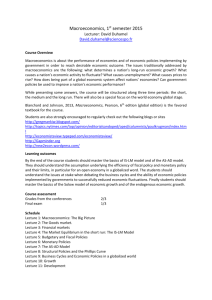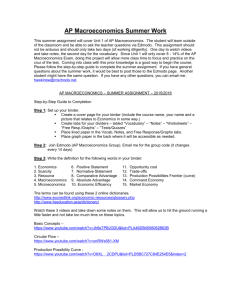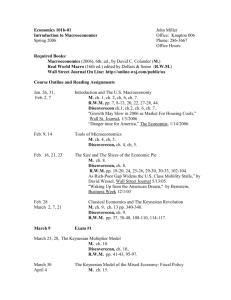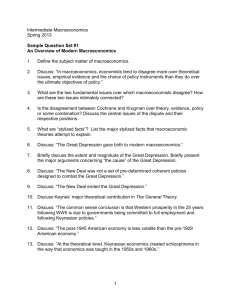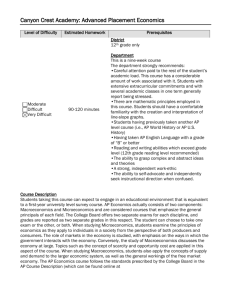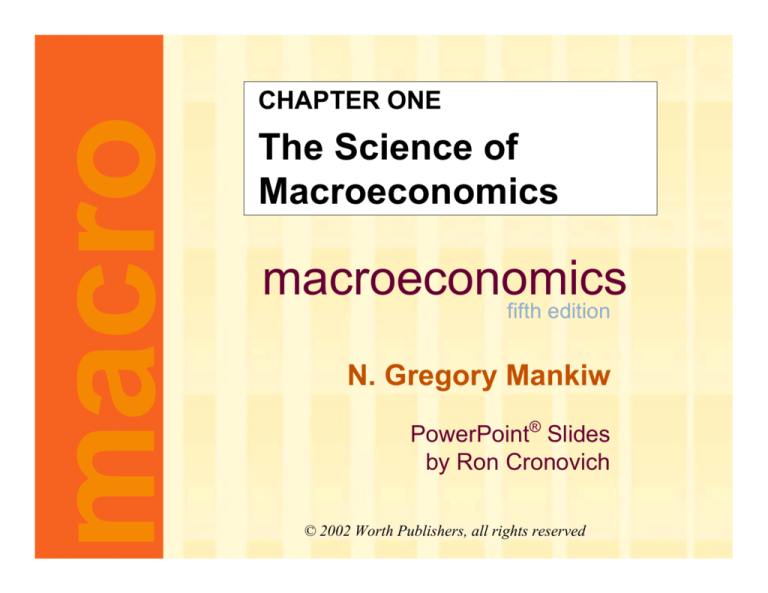
macro
CHAPTER ONE
The Science of
Macroeconomics
macroeconomics
fifth edition
N. Gregory Mankiw
PowerPoint® Slides
by Ron Cronovich
© 2002 Worth Publishers, all rights reserved
Learning objectives
This chapter introduces you to
the issues macroeconomists study
the tools macroeconomists use
some important concepts in
macroeconomic analysis
CHAPTER 1
The Science of Macroeconomics
slide 1
Important issues in macroeconomics
Why does the cost of living keep rising?
Why are millions of people unemployed,
even when the economy is booming?
Why are there recessions?
Can the government do anything to combat
recessions? Should it??
CHAPTER 1
The Science of Macroeconomics
slide 2
Important issues in macroeconomics
What is the government budget deficit?
How does it affect the economy?
Why does the U.S. have such a huge trade
deficit?
Why are so many countries poor?
What policies might help them grow out of
poverty?
CHAPTER 1
The Science of Macroeconomics
slide 3
U.S. Gross Domestic Product
in billions of chained 1996 dollars
10,000
9,000
8,000
7,000
6,000
5,000
lon
4,000
3,000
1970
1975
CHAPTER 1
1980
u
r
g
p
nu
1985
w
ard
t
d
ren
1990
…
1995
The Science of Macroeconomics
2000
slide 4
U.S. Gross Domestic Product
in billions of chained 1996 dollars
10,000
longest economic
expansion on record
9,000
8,000
7,000
Recessions
6,000
5,000
4,000
3,000
1970
1975
CHAPTER 1
1980
1985
1990
1995
The Science of Macroeconomics
2000
slide 5
Unemployment and social problems
Each one-point increase in the
unemployment rate is associated with:
920 more suicides
650 more homicides
4000 more people admitted to state mental
institutions
3300 more people sent to state prisons
37,000 more deaths
increases in domestic violence and
homelessness
CHAPTER 1
The Science of Macroeconomics
slide 6
Unemployment and earnings growth
%%
55
44
33
22
11
00
-1-1
-2-2
-3-3
-4-4
-5-5
1965
1965
1970
1970
1975
1975
1980
1980
1985
1985
1990
1990
1995
1995
2000
2000
growth
growthrate
rateofofinflation-adjusted
inflation-adjustedhourly
hourlyearnings
earnings
change
changeininUnemployment
Unemploymentrate
rate
CHAPTER 1
The Science of Macroeconomics
slide 7
Inflation and Unemployment in Election Years
year
1976
1980
1984
1988
1992
1996
2000
U rate
7.7%
7.1%
7.5%
5.5%
7.5%
5.4%
4.0%
CHAPTER 1
inflation rate
5.8%
13.5%
4.3%
4.1%
3.0%
3.3%
3.4%
elec. outcome
Carter (D)
Reagan (R)
Reagan (R)
Bush I (R)
Clinton (D)
Clinton (D)
Bush II (R)
The Science of Macroeconomics
slide 8
Prices: Flexible Versus Sticky
Market clearing: an assumption that prices
are flexible and adjust to equate supply and
demand.
In the short run, many prices are sticky---
they adjust only sluggishly in response to
supply/demand imbalances.
For example,
– labor contracts that fix the nominal wage
for a year or longer
– magazine prices that publishers change
only once every 3-4 years
CHAPTER 1
The Science of Macroeconomics
slide 9
Prices: Flexible Versus Sticky
The economy’s behavior depends partly on
whether prices are sticky or flexible:
If prices are sticky, then demand won’t
always equal supply. This helps explain
– unemployment (excess supply of labor)
– the occasional inability of firms to sell what
they produce
Long run: prices flexible, markets clear,
economy behaves very differently.
CHAPTER 1
The Science of Macroeconomics
slide 10
Outline of this book:
Introductory material
Classical Theory
(chaps. 1 & 2)
(chaps. 3-6)
How the economy works in the long run,
when prices are flexible
Growth Theory
(chaps. 7-8)
The standard of living and its growth rate
over the very long run
Business Cycle Theory
(chaps 9-13)
How the economy works in the short run,
when prices are sticky.
CHAPTER 1
The Science of Macroeconomics
slide 11
Outline of this book:
Policy debates
(Chaps. 14-15)
Should the government try to smooth business
cycle fluctuations? Is the government’s debt a
problem?
Microeconomic foundations
(Chaps. 16-19)
Insights from looking at the behavior of
consumers, firms, and other issues from a
microeconomic perspective.
CHAPTER 1
The Science of Macroeconomics
slide 12
CHAPTER 1
The Science of Macroeconomics
slide 13



